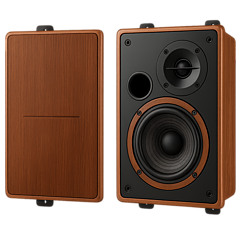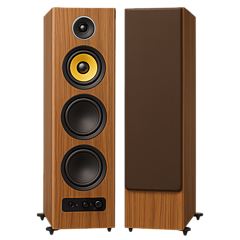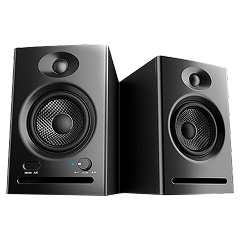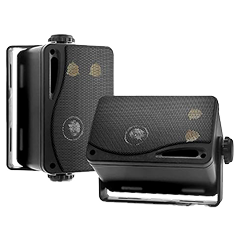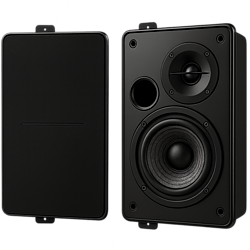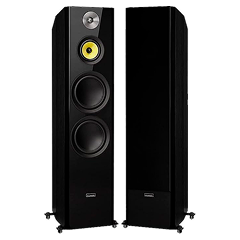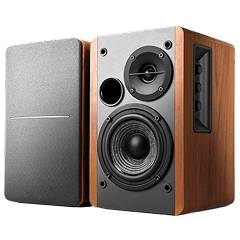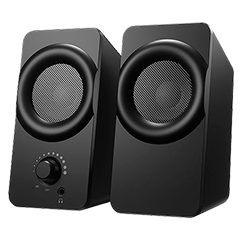Los altavoces activos más pequeños son la opción ideal cuando necesitas un sonido de alta calidad, pero no quieres que ocupen mucho espacio, como ocurriría con los altavoces tradicionales. Al igual que los altavoces pasivos de estantería o de pie, son ideales para espacios pequeños y situaciones en las que el tamaño, la colocación y la estética son un factor importante. Al elegirlos, debes tener en cuenta el tamaño de la sala, el estilo de la decoración y la potencia o presencia sonora que quieras lograr.
Aspectos clave sobre el posicionamiento de los altavoces
Los principios básicos sobre cómo ubicar los altavoces activos son los mismos que para los altavoces pasivos: la posición sigue siendo la clave para obtener un buen sonido. Evita colocarlos en las esquinas, proporciónales espacio suficiente sobre la superficie y ajusta su distancia respecto a las paredes, sobre todo si incorporan puertos de graves orientados hacia la parte trasera.
Valores de referencia:
- Deja al menos 15-20 cm entre el altavoz y las paredes.
- Procura no rodear los altavoces con libros u otros objetos, ya que eso puede afectar la ventilación y distorsionar la calidad del sonido.
- Usa soportes o almohadillas de desacoplamiento para minimizar el contacto con las superficies.
Prueba tanto altavoces con rejilla como sin ella, ya que la diferencia en cuanto a calidad de sonido puede ser grande. También piensa en si realmente te gustan los altavoces al natural, sin las rejillas puestas.
Altavoces activos o amplificados: ¿en qué se diferencian?
Lo primero que debes saber es que la diferencia básica entre un altavoz activo y uno amplificado está en la forma en que cada uno alimenta sus componentes de sonido. Un altavoz “amplificado” toma la señal de audio, la amplifica y luego usa un filtro de cruce para enviar cada rango de sonido al altavoz que mejor puede reproducirlo. Por su parte, un altavoz “activo” divide la señal antes de amplificarla, por lo que cada altavoz interno tiene su propio amplificador, lo que en teoría mejora la claridad y el detalle del sonido.
Por consiguiente, el precio también aumenta: un altavoz activo de dos vías necesita amplificadores separados para cada altavoz interno (graves y agudos), lo que supone hasta cuatro veces más componentes que un modelo amplificado convencional.
Esto se debe a que, en la práctica, en un par de altavoces amplificados normalmente uno de ellos se encarga de toda la amplificación y alimenta al otro (que, en efecto, actúa como un altavoz pasivo) a través de un cable de altavoz. Esto significa que solo uno de los altavoces necesita alimentación eléctrica, por lo que basta con asegurarte de que esté lo suficientemente cerca de un enchufe para conectarlo.
En los altavoces activos cada unidad tiene su propio sistema de amplificación, por lo que ambas deben conectarse a la red eléctrica. La comunicación entre ellas puede realizarse de manera inalámbrica o a través de un cable CAT5. Por lo tanto, además de pensar en la ubicación ideal de los altavoces para obtener el mejor desempeño acústico, es necesario tener en cuenta el requisito práctico de la conexión a la red eléctrica.
Los altavoces activos suelen ser más costosos por los circuitos de amplificación adicionales que tienen, permiten controlar con mayor precisión cada altavoz interno, lo que se traduce en un sonido más limpio y equilibrado.
Amplificación integrada: olvídate de la impedancia o la sensibilidad
Una ventaja de los altavoces activos o con alimentación propia es que la amplificación ha sido calibrada específicamente para los transductores que incorpora. No tienes que preocuparte por la sensibilidad, la impedancia o la potencia, ya que el fabricante ha ajustado todos esos detalles previamente para que tú no tengas que hacerlo y te resulte más fácil elegir.
Conectividad y puertos de entrada disponibles
En los sistemas de altavoces activos o amplificados, uno de los dos altavoces actúa como unidad principal que se encarga de las entradas físicas e inalámbricas, por lo que debes asegurarte de que tus altavoces sean compatibles con el tipo de sistema que tienes en mente.
Los altavoces amplificados suelen ofrecer Bluetooth como principal opción inalámbrica, especialmente los más baratos. Revisa la versión que emplean (la actual es la 5.4) y evita los modelos con versiones antiguas, ya que las anteriores a la 4 son menos estables y eficientes. No olvides revisar también los códecs compatibles, ya que son los sistemas que codifican y transmiten el audio digital por Bluetooth y algunos (como aptX Lossless el más avanzado hoy en día) ofrecen una calidad de sonido muy superior.
Los altavoces activos y los altavoces amplificados con mejores características también incluirán conectividad wifi. En la práctica, esto quiere decir que podrás reproducir música de forma inalámbrica desde tu móvil o tu red doméstica sin problemas. Además, muchos modelos permiten integrar tus servicios de streaming en la propia app de control para que puedas usar el móvil con total libertad.
No obstante, la compatibilidad con fuentes de audio distintas a los servicios de streaming deberá analizarse individualmente en función de cada modelo. Por ejemplo, si planeas conectar un tocadiscos, necesitarás una entrada de phono, ya que es imprescindible para este tipo de fuente. Por otro lado, para conectar un reproductor de CD, una pletina o incluso una videoconsola, necesitarás la entrada adecuada para tu altavoz principal.
Ciertos modelos de altavoces activos y amplificados incorporan una entrada HDMI ARC, lo cual permite conectar el televisor y disfrutar de un sonido más potente y nítido. Si te interesa esta característica, revisa que el equipo que planeas comprar la tenga integrada.
Conversión digital-analógica (DAC)
Cuando reproduces música digital, en especial por Bluetooth o wifi, los altavoces deben convertir la señal digital en analógica. Por eso conviene verificar que tu sistema activo o amplificado incorpore un buen DAC, ya que de él depende gran parte de la fidelidad del sonido.
La calidad de un CD es de 16 bits/44,1 kHz y los planes gratuitos de Spotify o Apple Music ofrecen una calidad bastante inferior, aunque hoy en día hay muchos servicios de streaming que permiten disfrutar de un sonido de calidad superior. Por ejemplo, Qobuz y TIDAL suelen ofrecer música a 24bit/192kHz, pero no le sacarás el mayor provecho a todo esto si tu sistema de altavoces no tiene el DAC necesario.
Un DAC que soporte 24 bits/96 kHz garantiza que puedas reproducir prácticamente cualquier audio de alta calidad sin problemas.
Qué puedes esperar en cuanto a sonido y rendimiento
Los altavoces activos o amplificados pequeños no pueden igualar la profundidad ni la escala de graves de los altavoces de suelo grandes, pero deberían ofrecer las siguientes prestaciones:
- Definición precisa en las frecuencias medias
- Agudos claros y naturales
- Rango dinámico adecuado
- Precisión rítmica
Lo mejor es reproducir distintos tipos de música a volúmenes realistas y prestar atención a la claridad, la separación de instrumentos y el equilibrio tonal. Si es posible, compáralos con otras opciones.


